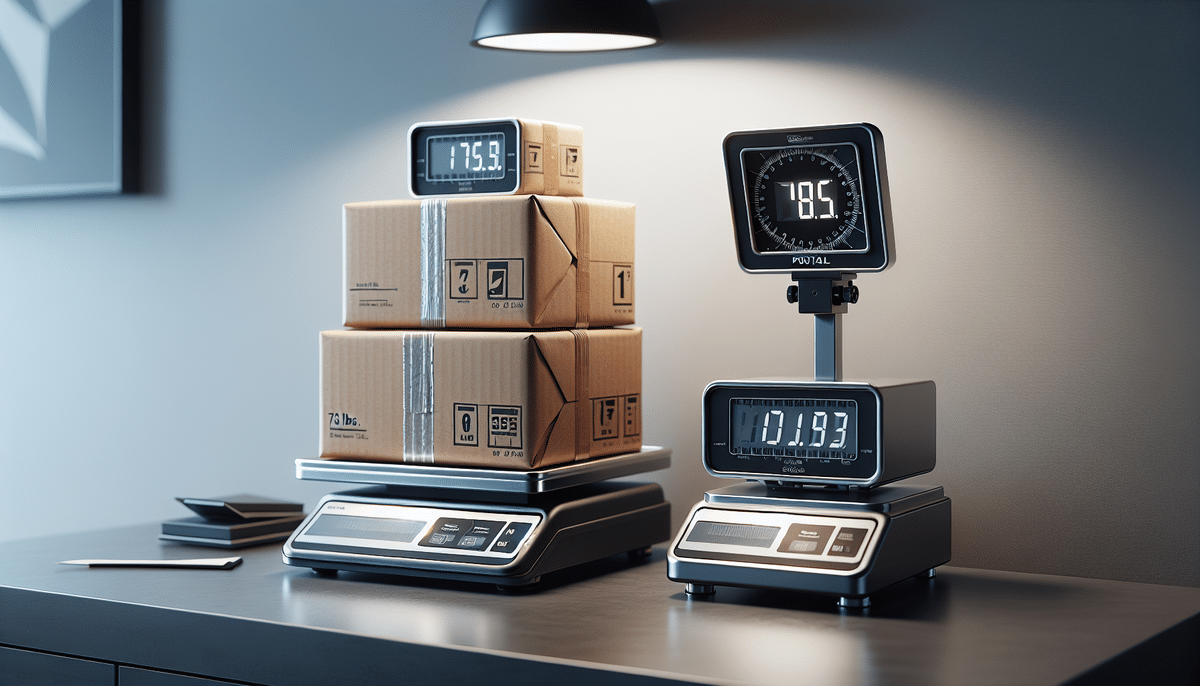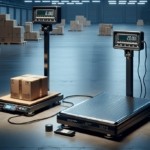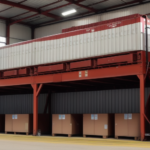My Weigh Ultraship 75 vs Accuteck ShipPro W-8580: Comprehensive Comparison for 2024
When it comes to shipping scales, there are numerous options available on the market. Two of the most popular models are the My Weigh Ultraship 75 and the Accuteck ShipPro W-8580. This article provides an in-depth analysis of both scales, comparing them across various categories to help you make an informed decision based on the latest industry standards and user feedback.
Introduction to Shipping Scales
Shipping scales are essential tools for accurately weighing packages before dispatch. Precise measurements ensure that you are not overpaying for shipping costs due to weight estimation errors. According to the United States Postal Service (USPS), providing accurate weights is mandatory and can prevent additional charges or penalties. Furthermore, accurate weighing helps avoid package rejections or delays, enhancing customer satisfaction and operational efficiency.
Using a shipping scale also streamlines the shipping process by enabling quick label printing and efficient package management. This is particularly beneficial for businesses handling large volumes of shipments or operating under tight deadlines.
Importance of Accurate Shipping Weights
For businesses that ship products to customers, a reliable shipping scale is indispensable. It allows for the accurate calculation of shipping costs, helping maintain budgetary control and operational efficiency. Additionally, precise weighing prevents discrepancies with customers regarding package weights, thus avoiding disputes and fostering trust.
Individuals who ship packages occasionally also benefit from using a shipping scale. It ensures compliance with carrier weight restrictions, preventing additional fees or package rejections. As e-commerce continues to grow, the importance of accurate shipping scales becomes increasingly evident. In 2023, the global e-commerce market was valued at approximately $5.7 trillion, underscoring the critical role of efficient shipping operations (Statista).
Key Features of My Weigh Ultraship 75
The My Weigh Ultraship 75 is a robust digital scale designed for both commercial and home use. Key features include:
- Capacity: Up to 75 pounds.
- Accuracy: Precision of 0.05 pounds.
- Display: Large, backlit LCD for clear visibility in various lighting conditions.
- Interface: User-friendly controls with easy unit switching and tare functions.
- Power: Dual power options via AC adapter or batteries.
Additional features include a detachable faceplate functioning as a weighing tray, facilitating the measurement of loose or irregularly shaped items. The faceplate is dishwasher safe, ensuring easy maintenance and sanitation.
According to industry reviews from TechRadar, the Ultraship 75 is praised for its durability and precision, making it a reliable choice for businesses with high shipping volumes.
Key Features of Accuteck ShipPro W-8580
The Accuteck ShipPro W-8580 is another leading shipping scale tailored for commercial use. Its standout features include:
- Capacity: Up to 85 pounds.
- Accuracy: Precision of 0.05 pounds.
- Display: Backlit LCD for enhanced readability.
- Interface: Simple controls with easy unit conversion and tare functions.
- Power: Flexible power options using AC adapter or batteries.
The ShipPro W-8580 features a detachable display that can be wall-mounted or placed on a desk, optimizing workspace usage. It also offers memory storage for up to 99 weight readings, allowing businesses to track shipping data efficiently.
Industry reports from the Shipping Industry Report highlight the ShipPro W-8580's reliability and user-friendly design, making it a favored choice among small to medium-sized enterprises.
Design and Build Quality Comparison
Both the My Weigh Ultraship 75 and Accuteck ShipPro W-8580 are constructed with durability in mind. The Ultraship 75 features a sturdy metal frame and rubberized feet to prevent slipping, offering a rugged and reliable design suitable for high-traffic environments. Conversely, the ShipPro W-8580 boasts a sleek, modern aesthetic with a lighter build, appealing to users who prioritize portability and space-saving features.
The Ultraship 75’s detachable faceplate provides versatility in weighing various items, while the ShipPro W-8580’s wall-mountable display enhances workspace efficiency. Both scales are backed by substantial warranties—30 years for the Ultraship 75 and 10 years for the ShipPro W-8580—underscoring their build quality and manufacturer confidence.
According to customer feedback on Trustpilot, the Ultraship 75 is favored for its robustness, whereas the ShipPro W-8580 is appreciated for its compact and versatile design.
Capacity and Accuracy Comparison
Both scales offer similar capacity and accuracy, with the Ultraship 75 handling up to 75 pounds and the ShipPro W-8580 accommodating up to 85 pounds. Both achieve precision down to 0.05 pounds, ensuring accurate measurements crucial for effective shipping cost calculations.
The Ultraship 75 is better suited for larger packages such as luggage or bulk items, thanks to its wider platform. In contrast, the ShipPro W-8580’s more compact design makes it ideal for smaller items like food portions or jewelry.
Ease of use varies slightly between the two. The Ultraship 75 offers a straightforward interface with large, easy-to-read numbers, while the ShipPro W-8580 includes additional features like tare functions and unit conversions, providing more flexibility for advanced users.
Display and Interface Comparison
Both the Ultraship 75 and ShipPro W-8580 feature large, backlit LCD displays, enhancing readability in various lighting conditions. The user interfaces are designed for simplicity, allowing easy navigation between different units of measurement and tare weights.
The Ultraship 75 includes additional interface features such as an auto-off function and a hold feature, which maintains the displayed weight even after the package is removed. These enhancements offer added convenience for users who require continuous monitoring without repeated measurements.
Power Source Comparison
Flexibility in power sources is a key advantage of both scales, as they can operate using either an AC adapter or batteries. This feature ensures that users can utilize the scales in various settings without being restricted by power outlets.
However, the Ultraship 75 boasts a longer battery life, making it more suitable for extended use in scenarios where frequent battery replacement could be inconvenient.
Portability and Storage Comparison
Portability and storage considerations differ between the two models. The Ultraship 75 is larger and heavier, designed for environments where durability and capacity are prioritized over mobility. Its rugged construction makes it ideal for permanent setups in shipping departments or warehouses.
In contrast, the ShipPro W-8580 is lighter and more compact, facilitating easy relocation within different areas of a workspace. This makes it particularly advantageous for businesses that require flexibility in their shipping operations.
Customer Reviews and Feedback
Both scales have garnered positive reviews for their accuracy, ease of use, and durability. Users commend the Ultraship 75 for its robust build and reliable performance, while the ShipPro W-8580 is praised for its compact design and user-friendly features.
However, some users have noted that the Ultraship 75 may be slightly more challenging to calibrate compared to the ShipPro W-8580. It is important for prospective buyers to consider their comfort with calibration processes when choosing between the two models.
According to reviews on Trustpilot, both scales effectively meet the needs of their respective user bases, with the Ultraship 75 appealing more to heavy-duty users and the ShipPro W-8580 catering to those seeking versatility and ease of use.
Pros and Cons of My Weigh Ultraship 75
Pros:
- Rugged, durable design
- Advanced interface with auto-off and hold functions
- Longer battery life
Cons:
- Slightly more difficult to calibrate
- May be too large/heavy for some users
Pros and Cons of Accuteck ShipPro W-8580
Pros:
- Lighter and more compact
- Easier to calibrate
- More affordable than My Weigh Ultraship 75
Cons:
- Less advanced interface overall
- Shorter battery life
Pricing Comparison
As of 2024, the Accuteck ShipPro W-8580 is generally more affordable than the My Weigh Ultraship 75. The ShipPro W-8580's lower price point makes it an attractive option for small businesses and individuals operating on a budget. However, the Ultraship 75 offers additional features and a longer warranty, which may justify its higher cost for users requiring enhanced durability and advanced functionalities.
Conclusion: Which One is the Better Choice?
Both the My Weigh Ultraship 75 and the Accuteck ShipPro W-8580 are excellent choices for shipping scales, each catering to different needs and preferences. The Ultraship 75 excels in durability and advanced features, making it ideal for businesses with high shipping volumes and demanding environments. On the other hand, the ShipPro W-8580 offers affordability, compactness, and ease of use, appealing to small businesses and users who require flexibility.
Your choice should be guided by your specific requirements, including package volume, workspace constraints, budget, and desired features. Regardless of which model you choose, both scales provide the accuracy and reliability necessary to optimize your shipping process and enhance customer satisfaction.
For more detailed comparisons and user experiences, visit the ShipScience Blog.






















